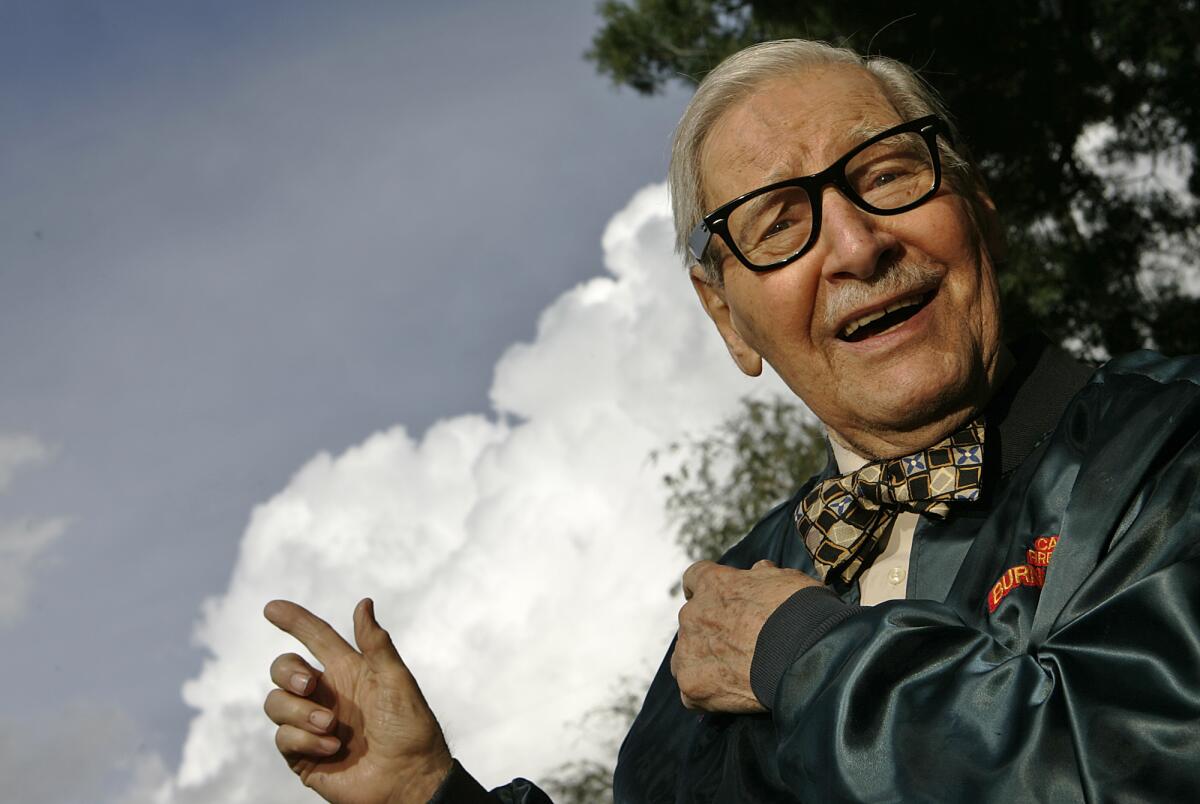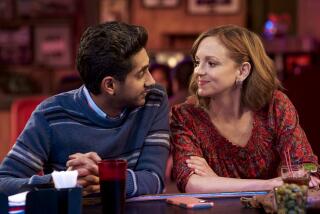‘Dr. George’ Fischbeck dies at 92; popular weatherman at KABC-TV

- Share via
George Fischbeck, a science teacher turned weatherman who joined KABC-TV in 1972 and spent nearly two decades exuberantly delivering the local forecast, has died. He was 92.
Fischbeck, who was known as “Dr. George,” died of natural causes early Wednesday morning at the Motion Picture & Television Fund retirement home in Woodland Hills, his daughter, Nancy Fischbeck, said.
A trained meteorologist, George Fischbeck was so enthusiastic about his subject that he sometimes forgot to talk about the next day’s weather.
“I must begin with an apology,” Fischbeck said on a 1978 broadcast. “Last Friday we got carried away again and we got everything in but the forecast.”
When the rare inclement weather threatened Los Angeles, his newscast’s ratings went up as viewers tuned in to see a seemingly real-life Mr. Wizard — complete with thick black-rimmed glasses, animated mustache and signature bow tie — race around the set.
Some people considered Fischbeck’s weathercasts “madcap performances,” according to a 1978 Times profile with the headline “Blue Skies for Dr. George.” The “doctor” referred to an honorary degree from the University of Albuquerque.
“I’m Channel 7’s father image,” Fischbeck said in 1978 while insisting that he was not its comedian because he refused to do jokes. “I am not a phony. I am not manufactured or contrived.”
He did, however, once call attention to the beginning of March by hauling a lion and a lamb into the TV studio.
The cult of personality that prevailed on local television in the 1970s “seemed to have reached a zenith” at KABC by 1979 when Fischbeck began receiving even wider play on the local news to exploit his huge following, former TV columnist Howard Rosenberg wrote in The Times.
In a 1981 report, People magazine compared Fischbeck to “a caged lion” who “stalks the weather map, prowls the sound stage ... and explodes into a frenzy of animation while delivering his forecasts. He candidly admits that cameramen should get hazard pay for trying to keep up with him.”
His Channel 7 colleagues said the enthusiastic weathercaster was no different when the cameras were turned off.
“What you saw on the air is really who he is,” Randy Roach, a former KABC News writer-reporter, wrote in a foreword to Fischbeck’s 2013 memoir. “Dr. George doesn’t have an off and on switch like many television personalities.”
“My personality — call me ebullient, if you insist — was shaped long ago,” Fischbeck said in 1977 in The Times. “When I talk about the weather, I come on strong, like an evangelist making a high-powered tour of Sin City.”
He honed his delivery during 23 years as a science teacher in Albuquerque schools.
“I could teach kids anything once I had their attention, and if I could make them smile, they would even remember it,” he told People in 1981.
After a University of New Mexico professor sought him out to host a children’s science program, Fischbeck appeared on the public television show for more than a decade. When Albuquerque’s NBC affiliate, KOB-TV hired Fischbeck as a meteorologist, the station was soon No. 1 in its market.
About 18 months later, Fischbeck was standing sentry over the weather at KABC, with his fist often clenched over his heart and his hair looking as if it had been wind-blown by the Santa Anas.
While serving in the Air National Guard, Fischbeck learned the basics of meteorology, which enhanced his authenticity, critics said. Twice a day, he would zip by the federal building in Westwood for briefings with government meteorologists that helped him prepare his chatty thrice-daily reports from the KABC studio in Hollywood.
“I have a compelling need to know how the forecast was arrived at,” Fischbeck said in 1977 in The Times. “My working rule is basic to the laws of science. There’s no point to vamping a situation. You either do something for real or don’t do it at all.”
George Richard Fischbeck was born July 1, 1922, in New Jersey, the eldest of four children of farmer George Fischbeck and his schoolteacher wife, Johanna. After the barn and house burned down on the farm they rented in Monmouth, N.J., his family moved to Farmingdale, N.J., to run a farm for his grandfather, according to Fischbeck’s memoir, “Dr. George: My Life in Weather.”
At 12, he learned to be outgoing while hawking truckloads of vegetables at a farmers market, he later recalled.
A ninth-grade teacher who asked such questions as “What makes thunder?” made Fischbeck curious about science and weather. In his high school yearbook, he declared his goal: “Science teacher.”
He spent World War II in the Army in Hawaii as a tank mechanic and worked in the weather department for the Air National Guard during the Korean War.
Growing up around immigrant workers from around the world on his family farm awakened his interest in anthropology, Fischbeck later recalled, so he moved to Albuquerque and studied the subject along with archaeology and geology at the University of New Mexico. He earned a bachelor’s degree and a master’s in education from the school and became a teacher.
With his wife, Susanne, he raised twins, Nancy and George Jr. His son was killed in an accidental shooting in 1977. He was 22.
“It changed my life completely,” Fischbeck told The Times the next year. “I’m sure I’m a different person now. I’ve got so much more compassion and understanding.”
He was so popular as a local weatherman his daughter once ran a thriving side business selling Dr. George collectibles that included buttons, T-shirts and umbrellas emblazoned with his bow-tied image.
Fischbeck handled the weather chores at KABC until the early 1990s then joined KCBS-TV in 1994 and spent a few years doing feature stories.
Well into his 80s, he volunteered as a docent at the L.A. Zoo, bringing animals to cheer rest-home patients. He raised money for firefighter charities and regularly participated in late-night stakeouts with the Los Angeles Police Department’s Volunteer Surveillance Team.
Often, passing motorists recognized him and waved. Fischbeck would customarily respond by giving them the thumbs-up sign and shouting, “Hey, good friends.”
In addition to his wife, Susanne, and daughter, Nancy, survivors include a granddaughter.
Times staff writer Christine Mai-Duc contributed to this report.
Nelson is a former Times staff writer.
More to Read
Start your day right
Sign up for Essential California for the L.A. Times biggest news, features and recommendations in your inbox six days a week.
You may occasionally receive promotional content from the Los Angeles Times.







